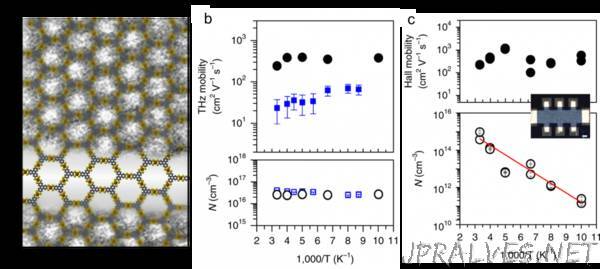
“A group of scientists has observed for the first time band-like electron transport in a conjugated two-dimensional (2D) metal-organic framework film (Nature Materials, “High-mobility band-like charge transport in a semiconducting two-dimensional metal–organic framework”). This semiconducting behavior, together with its cost-effective production, opens the path for employing metal-organic frameworks as electroactive materials in electronic devices.
The 21st century has seen a reinvention of how modern electronics impact our daily lives. Inorganic semiconductors as silicon, germanium or gallium arsenide are at the core of modern electronics; they are currently widely employed in e.g. computer chips, LEDs and solar cells. Inorganic semiconductors are highly pure, crystalline and hence ordered materials, these features make them good conductors of electricity under the application of an external bias (e.g. by applying a voltage). As a drawback, their high crystallinity and purity is reached by high temperature processing and then, they are very expensive to produce. A low-cost alternative are organic based semiconductors as e.g. polymers, these can be processed at room temperatures.
The scientists from TU Dresden/MPI-P/IMDEA Nanociencia/HZDR/MPI-CPS/Sofia have now developed and characterized a novel metal-organic framework (MOF) material, an organic graphene-like two-dimensional (2D) material made at room temperature that, remarkably, behaves electrically as inorganic semiconductors. These results open the path for exploiting MOFs as electroactive materials in electronic devices.
MOFs are crystalline coordination polymers that consist of metal ions connected by organic ligands. In the past, MOFs were regarded as insulators due to the large separation of metal centers by multi-atom, insulating organic ligands, etc. The new conjugated 2D MOF, produced by the team of Dr. Renhao Dong and Prof. Xinliang Feng in TU Dresden, is a highly crystalline film, obtained from trigonal planar organic ligands that are coordinated by square-planar atomic metal nodes. Such design rendering graphene-like conjugated planar geometry induces full delocalization of π-electrons in 2D, leading to a largely improved conductivity and a narrowed band gap.
The group led by Dr. Enrique Cánovas in MPI-P/IMDEA Nanociencia characterized the 2D MOFs by Terahertz (THz) spectroscopy, a tool that measure the conductivity of a sample in ultrafast time scales (10-12 seconds), locally (measuring currents over distances as short as 10-9 meters) and optically (without the need of applying perturbative metal contacts). These aspects enabled THz spectroscopy to assess the dependence with frequency for the conductivity in the 2D MOF, which turns out to obey a “Drude” behaviour; the same found in e.g. in highly crystalline silicon. From the Drude response, resolved by THz spectroscopy in the novel 2D MOFs, a world record electron mobility was inferred, that surpass previous values, obtained in insulating MOFs, by a factor of 10000.
The “Drude” behaviour implies that electrons can be displaced very easily over very long distances when a voltage is applied. As contrast, a Hall effect measurement by the group led by Dr. Artur Erbe in HZDR based on a “real” electronic device further confirmed the high mobility in this novel MOF. These results open the path for exploiting low cost MOFs in a plethora of novel applications where long-range motion of electrons is desired (e.g. in electronic devices).
This research is a joint collaboration between scientists from Germany, Bulgaria and Spain. The Technical University of Dresden, the Max Planck Institute for Polymer Research, the Max Planck Institute for Chemical Physics of Solids, the Helmholtz Zentrum in Dresden, the Wilhem-Ostwald-Institute of Physical and Theoretical Chemistry in Leipzig, The University of Sofia and the Madrid’s Institute of Advanced Studies IMDEA Nanociencia contributed to this work.”
